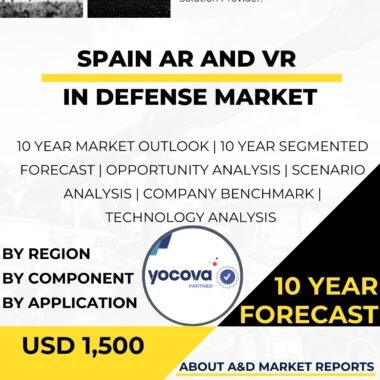Description
Saudi Arabia AR & VR in Defense Market
Saudi Arabia AR & VR in Defense Market sector has been witnessing a transformative shift with the integration of Augmented Reality (AR) and Virtual Reality (VR) technologies. These cutting-edge innovations are revolutionizing the way military personnel are trained, missions are planned, and situational awareness is enhanced, positioning the Kingdom at the forefront of the global defense market.
AR and VR have emerged as disruptive forces in defense due to their ability to create immersive and interactive experiences. In training and simulation, these technologies provide realistic scenarios that enable soldiers to hone their skills in a safe and controlled environment. This results in improved tactical decision-making, marksmanship, and battlefield strategies, thereby significantly enhancing overall combat readiness. By reducing the need for live-fire exercises and expensive field operations, AR and VR offer cost-saving advantages in the long run.
One of the key applications of AR and VR in the defense sector is enhancing situational awareness. AR-enabled heads-up displays and VR-based command centers provide real-time information to military personnel, giving them a comprehensive view of the battlefield. This heightened awareness empowers commanders to make well-informed decisions swiftly, thus increasing the likelihood of mission success and reducing the risk of casualties.
Moreover, AR-based maintenance systems have found their way into the Saudi defense industry, providing technicians with step-by-step instructions overlaid onto the actual equipment. This streamlines the maintenance and repair processes, minimizing downtime and errors, and ultimately contributing to the longevity and operational efficiency of military assets.
VR platforms have also proven invaluable in mission planning. Military leaders can virtually explore terrains, scout potential obstacles, and rehearse operations, thereby improving mission effectiveness and mitigating risks before executing plans in the field. This capability is particularly vital for complex and high-stakes operations, enhancing the overall effectiveness of the Saudi Arabian Armed Forces.
Saudi Arabia’s defense market, backed by one of the largest defense budgets globally, is increasingly recognizing the potential of AR and VR technologies. The Kingdom has been fostering strategic partnerships with leading defense companies and technology providers to accelerate the integration of AR and VR in its defense operations. These collaborations aim to capitalize on the expertise of global leaders in AR and VR development, ensuring that the Saudi defense sector remains at the cutting edge of technological advancements.
The adoption of AR and VR technologies in Saudi Arabia’s defense industry presents numerous opportunities and advantages. Firstly, it enhances the training and readiness of military personnel, reducing the time required to develop critical skills and capabilities. This directly contributes to bolstering the Kingdom’s national security and defense capabilities.
Furthermore, the utilization of AR and VR technologies in training and simulation can potentially lead to substantial cost savings. The reduction in live-fire exercises and field operations translates into financial benefits, allowing resources to be allocated to other crucial defense areas.
Additionally, AR and VR technologies play a pivotal role in improving decision-making at various levels of the military hierarchy. By providing real-time and comprehensive data, these technologies empower commanders and military leaders to make informed and accurate choices in high-pressure situations. This, in turn, increases the effectiveness and efficiency of military operations and reduces the likelihood of undesirable outcomes.
Another advantage lies in the potential for local industry development. With the integration of AR and VR in defense, opportunities arise for Saudi Arabian companies to participate in technology development, manufacturing, and maintenance. This can stimulate economic growth and job creation within the Kingdom, fostering a thriving defense technology ecosystem.
Despite the promising prospects, the adoption of AR and VR in Saudi Arabia’s defense sector also presents several challenges and roadblocks. Ensuring the security of these technologies is of paramount importance, as any vulnerabilities could compromise classified information and operational security. Robust cybersecurity measures must be put in place to safeguard sensitive data and assets.
Additionally, the initial investment required for the implementation of AR and VR technologies, along with the training of personnel, can be substantial. Adequate planning and resource allocation are essential to ensure a seamless integration process and maximize the return on investment.
Furthermore, integrating AR and VR solutions seamlessly with existing defense infrastructure may pose technical challenges. Compatibility issues and interoperability concerns must be addressed to ensure that these technologies function cohesively with other defense systems and platforms.
In conclusion, Saudi Arabia’s defense sector is embracing the transformative potential of AR and VR technologies. The integration of these innovations in training, simulation, situational awareness, maintenance, and mission planning is driving significant improvements in the Kingdom’s defense capabilities. By strategically capitalizing on the advantages offered by AR and VR, while mitigating the associated challenges, Saudi Arabia is positioning itself as a leading player in the global defense market and a pioneer in the application of cutting-edge technologies in military operations.




